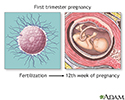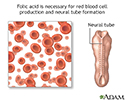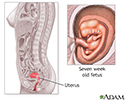Folic acid and birth defect prevention
Prevention of birth defects with folic acid (folate)Information
Taking folic acid before and during pregnancy can reduce the risk for certain birth defects. These include spina bifida, anencephaly, and some heart defects.
Before and during pregnancy
Most women know they need to see a doctor or midwife and make lifestyle changes while pregnant. But, it is just as important to start making changes...

Anencephaly
Anencephaly is the absence of a large part of the brain and the skull.

Experts recommend women who can become pregnant or who plan to become pregnant take at least 400 micrograms (µg) of folic acid every day, even if they are not expecting to become pregnant.
This is because many pregnancies are unplanned. Also, birth defects often occur in the early days before you may know you are pregnant.
If you become pregnant, you should take a prenatal vitamin, which will include folic acid. Most prenatal vitamins contain 800 to 1000 mcg of folic acid. Taking a multivitamin with folic acid helps ensure that you get all the nutrients you need during pregnancy.
Women with a history of delivering a baby with a neural tube defect may need a higher dose of folic acid. If you have had a baby with a neural tube defect, you should take 5mg of folic acid every day, even when you are not planning to become pregnant. If you plan to become pregnant, you should talk to your health care provider about whether you should increase your folic acid intake to 5 milligrams (mg) each day during the month before you become pregnant until at least the 12th week of pregnancy.
References
Carlson BM. Developmental disorders: causes, mechanisms, and patterns. In: Carlson BM, ed. Human Embryology and Developmental Biology. 7th ed. Philadelphia, PA: Elsevier; 2024:chap 8.
Chambers M, Berger DS, West EH. Nutrition during pregnancy. In: Landon MB, Galan HL, Jauniaux ERM, et al, eds. Gabbe's Obstetrics: Normal and Problem Pregnancies. 9th ed. Philadelphia, PA: Elsevier; 2025:chap 6.
Copp AJ, Greene NDE. Pathophysiology of neural tube defects. In: Polin RA, Abman SH, Rowitch DH, Benitz WE, Fox WW, eds. Fetal and Neonatal Physiology. 6th ed. Philadelphia, PA: Elsevier; 2022:chap 169.
US Preventive Services Task Force, Barry MJ, Nicholson WK, et al. Folic Acid Supplementation to Prevent Neural Tube Defects: US Preventive Services Task Force Reaffirmation Recommendation Statement. JAMA. 2023;330(5):454-459. PMID: 37526713 pubmed.ncbi.nlm.nih.gov/37526713/.
-
First trimester of pregnancy - illustration
The first trimester of pregnancy is the first three months after conception. Signs of early pregnancy are missed menstrual periods, fatigue, breast enlargement, abdominal distention, and nausea. During this period of time all organ development takes place so the fetus is most susceptible to damage from toxins, drugs, and infections.
First trimester of pregnancy
illustration
-
Folic acid - illustration
Studies show that an increase in the mother's dietary folic acid before conception and during the first month of pregnancy reduces the risk of having a child with a neural tube defect. The recommendation is that women of childbearing years take a daily folic acid supplement.
Folic acid
illustration
-
Early weeks of pregnancy - illustration
The first trimester of a pregnancy is a time of incredible growth and development. A 7-week fetus will have begun to develop all essential organs.
Early weeks of pregnancy
illustration
-
First trimester of pregnancy - illustration
The first trimester of pregnancy is the first three months after conception. Signs of early pregnancy are missed menstrual periods, fatigue, breast enlargement, abdominal distention, and nausea. During this period of time all organ development takes place so the fetus is most susceptible to damage from toxins, drugs, and infections.
First trimester of pregnancy
illustration
-
Folic acid - illustration
Studies show that an increase in the mother's dietary folic acid before conception and during the first month of pregnancy reduces the risk of having a child with a neural tube defect. The recommendation is that women of childbearing years take a daily folic acid supplement.
Folic acid
illustration
-
Early weeks of pregnancy - illustration
The first trimester of a pregnancy is a time of incredible growth and development. A 7-week fetus will have begun to develop all essential organs.
Early weeks of pregnancy
illustration
Review Date: 5/22/2025
Reviewed By: LaQuita Martinez, MD, Department of Obstetrics and Gynecology, Emory Johns Creek Hospital, Alpharetta, GA. Also reviewed by David C. Dugdale, MD, Medical Director, Brenda Conaway, Editorial Director, and the A.D.A.M. Editorial team.




